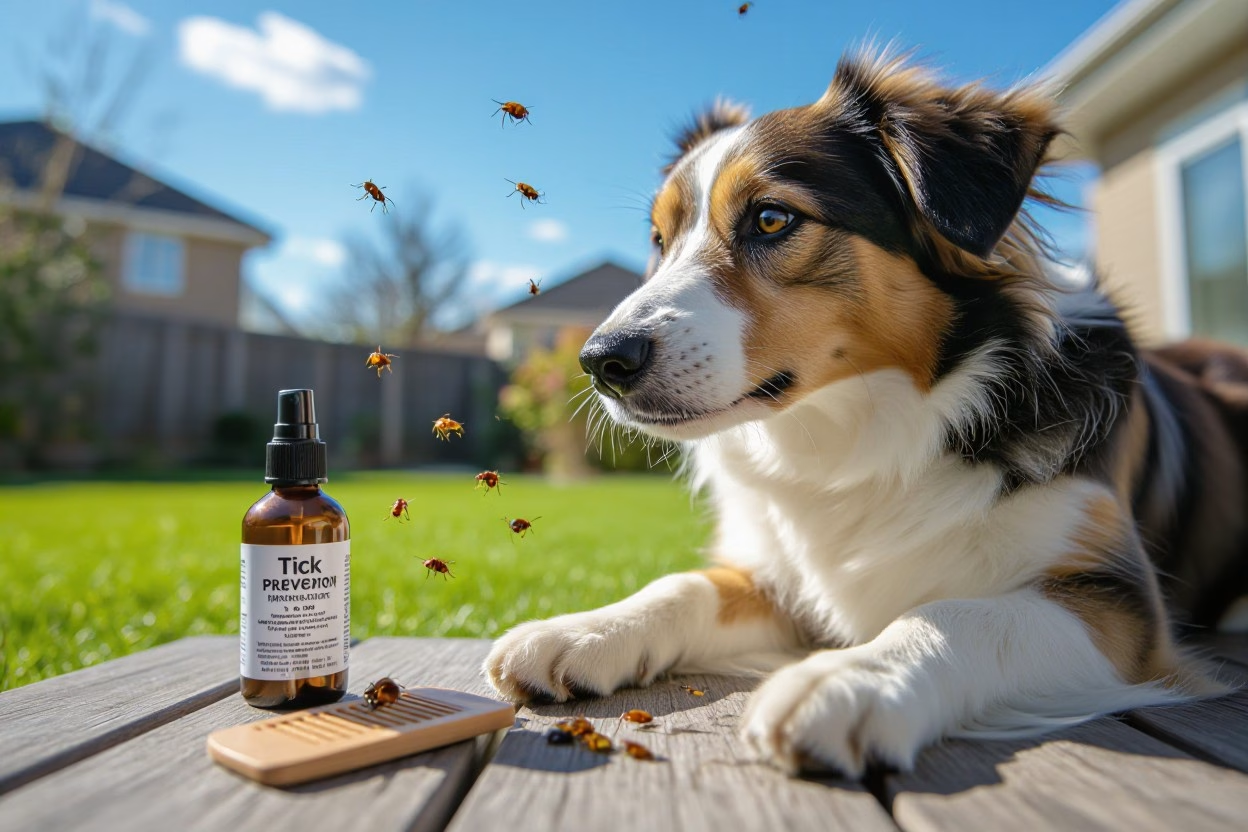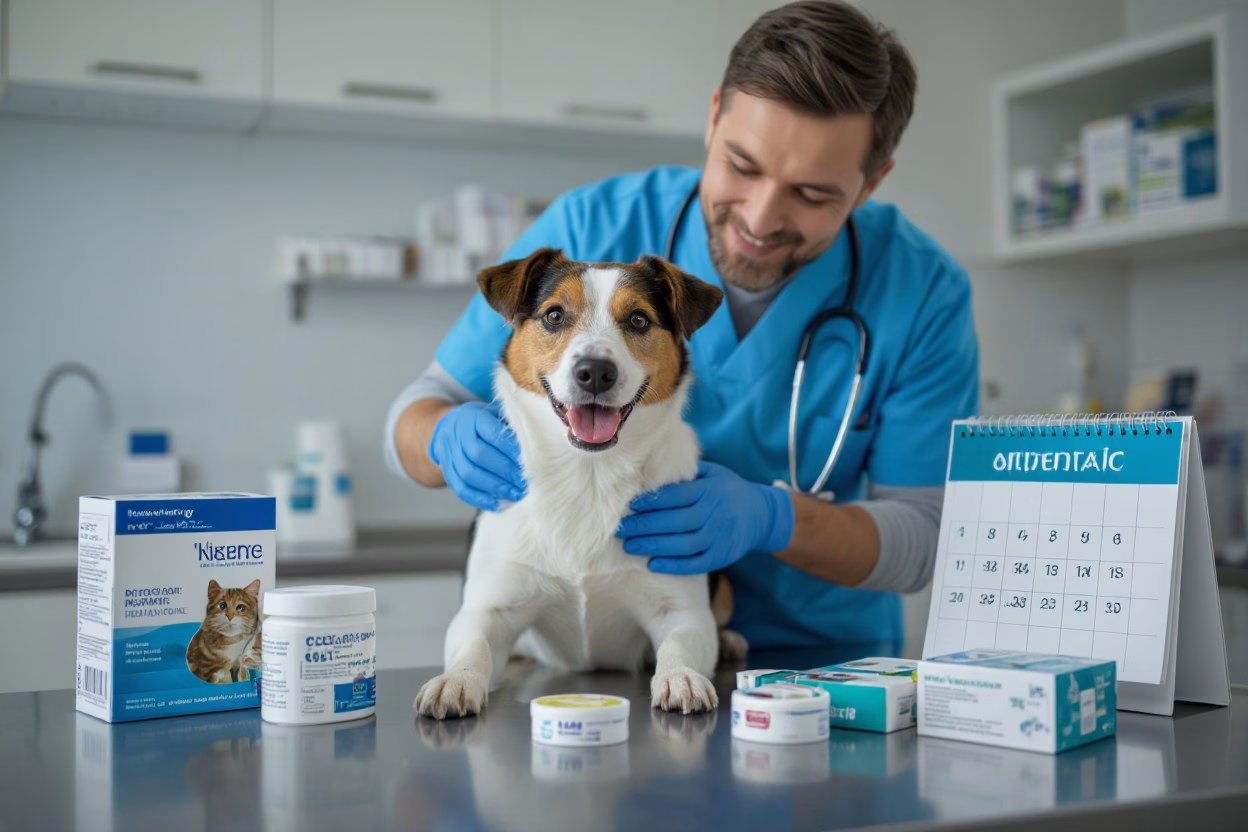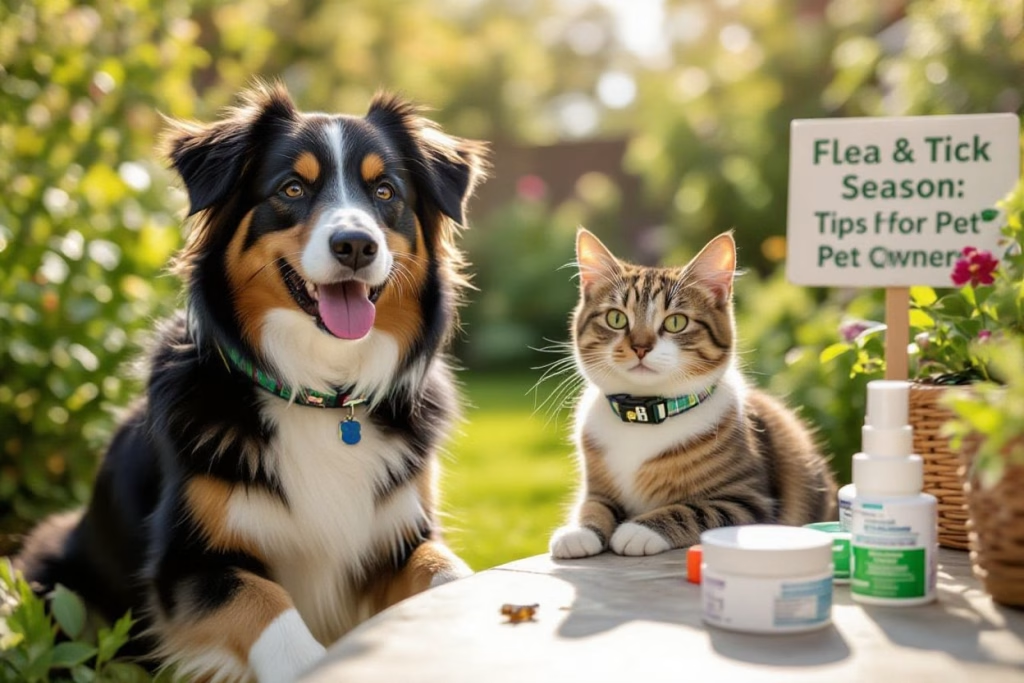Just as warmer months arrive in Harrogate, you should be alert to fleas in Harrogate and ticks that can transmit diseases like Lyme to your pet and family; this guide explains when the flea and tick season UK runs, how to spot bites and infestations, and how you can protect your dog or cat with vet-recommended prevention to keep your pet healthy year-round.
Flea & Tick Season: The Timeline in Harrogate
Peak flea and tick activity in Harrogate generally runs from March to October, though warm, humid indoor conditions mean you can see fleas in Harrogate year‑round. Fleas reach highest activity in late spring and summer, answering the question when are fleas most active, while ticks surge in spring and early summer and again in autumn. You should plan prevention year‑round, especially if your pet visits parks, woods or riverside paths.
Vital Months to Watch
Expect the busiest period for fleas and ticks between April and September, with tick peaks often in April–June and September–October. Apply monthly vet‑recommended products — spot‑ons, collars or prescription tablets — and arrange regular checks after walks. For cats use a flea treatment for cats that your vet recommends to match behaviour and lifestyle; these timings reflect top flea season advice for the UK.
Local Insights on Tick Habitats
Wooded areas around Harrogate & Knaresborough, the Stray, and riverbanks like the Nidd Gorge are prime tick hotspots; ticks favour shaded, damp undergrowth and hedgerows. You should check your dog or cat after any walk through long grass or woodland—focus on ears, neck, armpits and between toes—and know how to remove a tick safely or contact Your Family Vets Harrogate for help.
Ticks in the Harrogate area are often Ixodes ricinus, the common UK species that can transmit infections leading to tick bites in dogs becoming serious; questing ticks typically sit 20–90 cm above ground on vegetation. Keep to paths, trim garden edges, and use combined parasite prevention as part of flea prevention tips UK; if you find an engorged tick, contact Your Family Vets Harrogate for removal and advice on next steps.
The Stakes: Why Fleas and Ticks Pose Real Risks
Fleas and ticks do far more than annoy your pet: a female flea can lay up to 50 eggs a day, enabling infestations to explode in weeks during flea and tick season UK (typically March–October), while ticks can transmit pathogens if attached for 24–48 hours. In Harrogate, fleas in Harrogate and local woodland ticks mean a single walk can start a household problem, so fast detection and vet-recommended action matter.
Health Implications for Pets
Fleas commonly trigger flea allergy dermatitis (FAD), severe itching and hair loss; heavy infestations risk anaemia in puppies and kittens. Ingesting an infected flea can give your cat or dog tapeworms, so prompt flea treatment for cats and dogs is key. Ticks lead to fever, lameness and, in some cases, Lyme disease—tick bites in dogs should be monitored and treated by your vet with flea treatment vet recommended products.
The Broader Impact on Households
An infestation quickly moves off your pet: eggs in carpets and soft furnishings restart cycles for weeks, and humans can get bitten too. Effective control needs environmental steps—vacuuming daily, disposing of dust bags, and washing bedding at 60°C—plus coordinated treatment of all pets. Follow practical flea prevention tips UK and seek flea season advice to avoid repeated treatments and extra costs.
Local cases in Harrogate show a typical timeline: without combined pet and home treatment, fleas can persist for 8–12 weeks. You should vacuum carpets and upholstery, launder pet bedding weekly at 60°C, treat garden edges and keep grass short. Never rely solely on over-the-counter sprays—use vet-recommended spot-on, collars or prescription tablets and, if unsure how to remove a tick, contact us. For tailored parasite prevention plans and treatment, contact Your Family Vets Harrogate for advice or in-clinic care.

Spotting Trouble: Signs Your Pet May Be Infested
Persistent scratching, sudden hair loss or irritated skin point to fleas, while a new, small lump or sore spot often hides a tick. Adult fleas can lay up to 50 eggs a day, so populations explode quickly; ticks may stay attached for 24–48+ hours and tick bites in dogs can transmit Lyme disease. Check ears, neck, under collar and between toes after walks around Harrogate woodlands and contact Your Family Vets Harrogate for advice if you find anything suspicious.
Flea Indicators
Look for constant scratching, hair thinning over the back or base of the tail, and tiny black specs of flea dirt (dried blood) that turn red on damp paper. You might spot fast-moving adults or see pets chewing paws at night; fleas are most active from spring through autumn, so when are fleas most active affects risk. Ask about flea treatment vet recommended and flea treatment for cats if you detect signs.
Recognising Ticks
Find a small grey-brown bump firmly attached to the skin—often in ears, around the eyes, neck or between toes—and you’ve likely found a tick. Sizes range from a pinhead to pea-sized when engorged; prompt removal matters, so know how to remove a tick safely and contact Your Family Vets Harrogate if you’re unsure or see redness, swelling or lethargy afterwards.
Use a dedicated tick removal tool, grasping the head close to the skin and twisting slowly to avoid leaving mouthparts behind, rather than squeezing the body. After removal cleanse with a pet-safe antiseptic, note the bite date and monitor for fever, lameness or reduced appetite over the next 2–4 weeks; seek vet attention if signs develop or if the bite site becomes infected—this is part of good flea season advice and flea prevention tips UK thinking.
Essential Strategies for Flea and Tick Prevention
You should use a layered approach: combine a flea treatment vet recommended product with daily checks and environmental control. Apply spot-on or oral treatments on their schedule (many spot-ons are monthly; some collars like Seresto last 8 months), wash bedding weekly at 60°C, and avoid long grass during peak months (March–October). Keep records of treatments and book advice with Your Family Vets Harrogate if infestations persist.
Recommended Product Use
Choose products based on species and lifestyle: monthly spot-on for most dogs and cats, prescription flea/tick tablets for heavy tick exposure, or an 8-month Seresto collar where suitable. For cats select a licensed flea treatment for cats only. Over-the-counter options can be less reliable; consult Your Family Vets Harrogate for tailored, flea treatment vet recommended regimens and dosing for multi-pet households.
Practical Everyday Tips
Check your pet after every walk—focus on ears, neck, between toes and under collars—and groom weekly to spot fleas in Harrogate early. Vacuum high-traffic areas twice weekly during peak months, wash bedding at 60°C, and keep lawns trimmed to reduce tick habitat; carry a tick removal tool and know how to remove a tick safely. Contact Your Family Vets Harrogate for personalised flea prevention tips UK.
- Use a flea and tick season UK calendar to time monthly treatments.
- Carry a dedicated tick remover and learn how to remove a tick properly.
- Keep bedding and soft furnishings laundered to disrupt flea life cycles.
- Limit access to long grass and wooded edges where ticks are common.
- Recognizing tick bites in dogs or sudden scratching should prompt vet contact.
Perform targeted checks after outings to known tick hotspots around Harrogate and Knaresborough; examine under collars and inside ears where ticks hide, and comb with a fine-tooth flea comb for black flea dirt. Vacuum carpets and dispose of vacuum bags immediately, and treat all pets in the home simultaneously to prevent reinfestation. Keep a treatment log and seek flea season advice from Your Family Vets Harrogate if you see persistent signs or multiple pets are affected.
- Check paws, armpits and groin areas where ticks attach.
- Use a flea comb weekly to detect fleas in Harrogate before full infestation.
- Wash bedding at 60°C and vacuum carpets to remove eggs and larvae.
- Keep up-to-date with treatments so you know when are fleas most active in your area.
- Recognizing early signs and contacting Your Family Vets Harrogate can prevent escalation.
Safe Tick Removal: A Step-by-Step Guide
You should aim to remove ticks promptly — transmission risk for many infections rises after about 24–48 hours. Use steady, calm movements to reduce stress for your pet and avoid squeezing the tick’s body; that increases the chance of disease transfer. If you’re unsure or the tick is engorged, contact Your Family Vets Harrogate for help.
| Step | Action |
| Prepare | Wear gloves, have a tick tool or fine-tipped forceps, antiseptic and a sealed container ready. |
| Restrain | Keep your dog or cat steady — ask a helper to calm and hold if needed. |
| Remove | Grasp the tick close to the skin and pull upward with steady pressure; avoid twisting or squeezing the body. |
| Clean | Clean the bite with pet-safe antiseptic and apply a small antiseptic pad; watch for bleeding. |
| Dispose & Monitor | Place the tick in a sealed container (or take a photo), note the date, and monitor for signs of infection. |
Tools You Need
Keep a purpose-made tick removal tool or fine-tipped forceps, gloves, antiseptic wipes or chlorhexidine, and a sealed container or zip bag for the tick; a smartphone photo helps identification. Avoid using bare fingers or methods that squeeze the tick’s abdomen — never use oil, burns or excessive force when learning how to remove a tick.
Post-Removal Care
After removal, clean the area and check daily for redness, swelling or discharge. Note the date of removal and watch your pet for lethargy, lameness, fever or changes in appetite — signs associated with tick bites in dogs and other infections; contact Your Family Vets Harrogate if any appear.
If mouthparts remain, do not probe aggressively; contact the clinic for safe removal. Consider saving the tick in a sealed container or photo for identification if your pet develops symptoms. Monitor for 30 days, with particular attention during flea and tick season UK peaks (spring and early summer, and again in autumn). Ask Your Family Vets Harrogate about whether post-exposure checks or treatment are advised based on the tick type, attachment time and your pet’s vaccination or prevention status.

Trusted Protection: Veterinary-Approved Solutions
You can rely on a combination of products to cover different risks during flea and tick season UK; monthly spot-on treatments for regular control, prescription oral tablets (e.g. Bravecto/NexGard) for fast knockdown and multi-month cover, and long-life collars like Seresto for continuous protection. For fleas in Harrogate and local wooded areas, a veterinary plan tailored to your pet’s weight, age and lifestyle gives the best results — ask for flea treatment vet recommended options.
Comparing Options: Treatments and Products
Common choices and how they fit your pet
| Product | Notes / Best for |
|---|---|
| Spot-on (monthly) | Fast flea kill, some tick protection; good for cats and dogs needing monthly control. |
| Oral prescription tablets | Rapid effect; Bravecto covers ticks up to 12 weeks — ideal if you walk in Knaresborough woods. |
| Seresto collar | Up to 8 months continuous protection; handy for outdoor dogs and multi-pet households. |
| Shampoos/sprays | Useful for immediate relief but not sole prevention; combine with vet-recommended monthly products. |
Match treatment to your pet: choose flea treatment for cats that’s licensed for felines, select oral or collar options if you worry about tick bites in dogs, and follow local flea prevention tips UK — especially during spring–autumn when when are fleas most active peaks. Ask Your Family Vets Harrogate for personalised flea season advice.
The Importance of Vet Guidance
Consulting your vet ensures dosing by weight, checks for contraindications (pregnancy, young or medically compromised pets) and aligns parasite control with any concurrent worming or vaccination plan; vets also advise on household treatment and biosecurity to stop reinfestation.
Local knowledge matters: tell your vet if you walk in Harrogate’s wooded areas or have had recent tick bites in dogs; they can arrange testing if a tick has been attached >48 hours, provide prescription-only options and offer a year-round prevention plan — contact Your Family Vets Harrogate for tailored advice.
To wrap up
So as flea and tick season UK ramps up, you should stay vigilant from spring to autumn and treat year‑round if needed; check your pet after walks, use vet-recommended flea treatment for cats or dogs, and learn how to remove a tick safely. If you spot fleas in Harrogate, tick bites in dogs, or need flea season advice, contact Your Family Vets Harrogate for tailored prevention and treatment.
FAQ
Q: When does flea & tick season start in Harrogate?
A: In the UK flea and tick season typically runs from spring through autumn—roughly March to October—but fleas can be active year‑round indoors. Fleas in Harrogate increase in warm, humid weather and ticks are most active in spring and early summer and again in autumn. Local hotspots include wooded and grassy areas around Harrogate and Knaresborough. For tailored flea season advice contact Your Family Vets Harrogate.
Q: How do fleas and ticks affect my dog or cat?
A: Fleas cause itching, red or flaky skin, flea dirt (tiny black specks), allergic dermatitis and can transmit tapeworm. Ticks attach to the skin and can transmit infections—tick bites in dogs may lead to Lyme disease or other illnesses. Both parasites can bite humans and make pets uncomfortable; elderly or very young animals, and those with health issues, are at higher risk of serious problems.
Q: What are the best prevention steps for pets in Harrogate?
A: Use vet‑recommended monthly spot‑on treatments, prescription flea/tick tablets or an effective collar (for example, Seresto) and consider combination products that cover fleas, ticks and worms. Check pets after walks (ears, neck, between toes), keep bedding clean, vacuum carpets and soft furnishings often, groom regularly and avoid long grass and dense undergrowth. For personalised flea prevention tips UK owners can rely on, ask Your Family Vets Harrogate for a flea treatment vet recommended plan.
Q: How do I remove a tick safely from my pet?
A: Use a dedicated tick removal tool or fine‑tipped tweezers; grasp the tick as close to the skin as possible and pull upward with steady, even pressure or twist gently until it releases—do not squeeze the tick’s body. Clean the bite area with a pet‑safe antiseptic and monitor for redness, swelling or behavioural change. If you’re unsure or the bite looks infected, have Your Family Vets Harrogate remove it safely and advise on next steps. Search “how to remove a tick” for official guidance, but if in doubt contact your vet.
Q: When should I contact the vet about fleas or ticks?
A: Contact the vet if fleas persist despite treatment, if your pet is scratching excessively or losing fur, if a tick bite shows swelling, redness, discharge or if your pet becomes lethargic, off their food or shows lameness after a tick bite. Also seek veterinary advice for flea treatment for cats that are pregnant, nursing or have health conditions, and to set up year‑round parasite prevention plans. Your Family Vets Harrogate can provide examination, prescribe flea treatment vet recommended options and offer ongoing parasite prevention advice or treatment.

